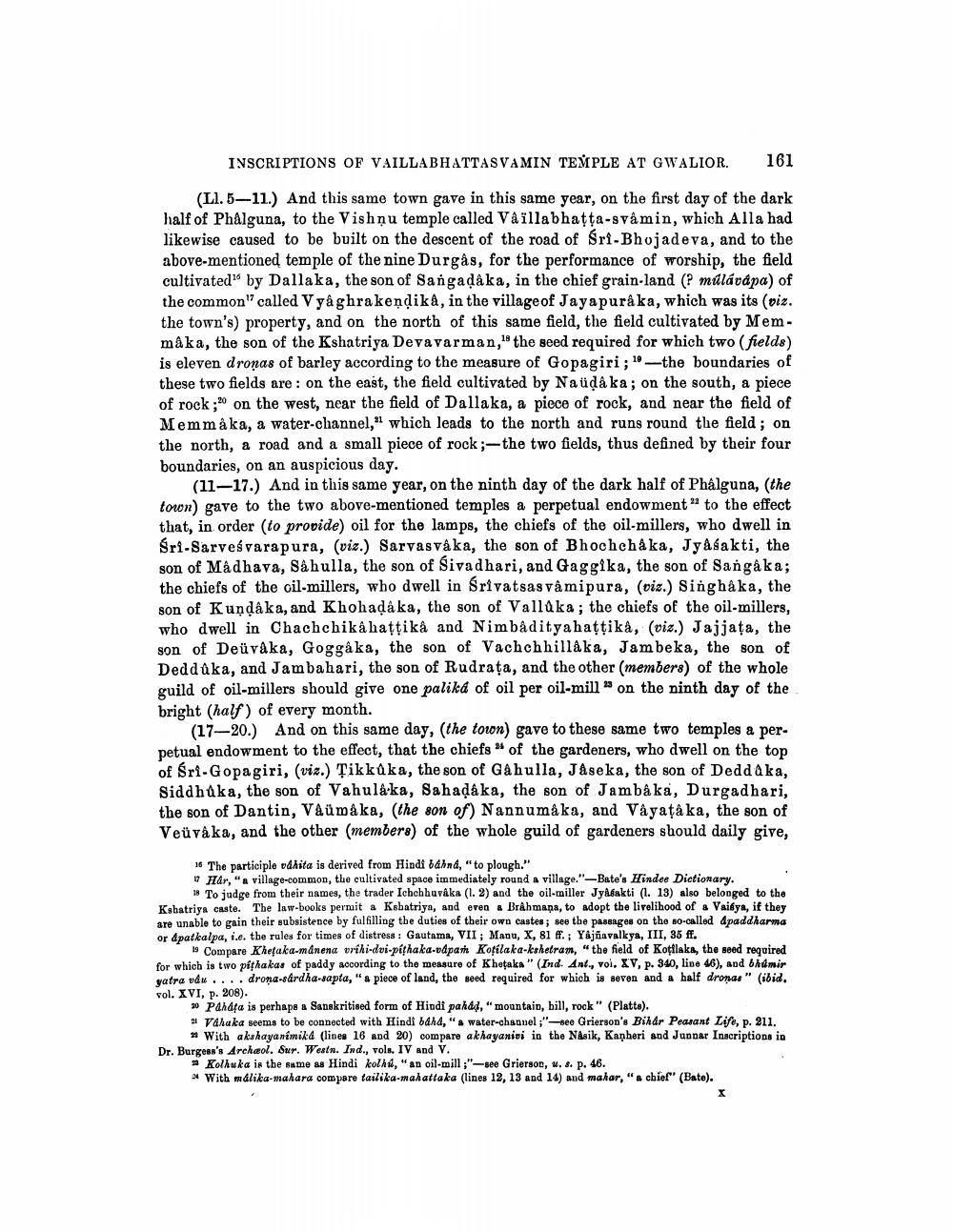________________
INSCRIPTIONS OF VAILLABHATTASVAMIN TEŇPLE AT GWALIOR.
161
(L1.5-11.) And this same town gave in this same year, on the first day of the dark half of Phålguna, to the Vishnu temple called Vaillabhatta-svå min, which Alla had likewise caused to be built on the descent of the road of Sri Bhojadeva, and to the above-mentioned temple of the nine Durgås, for the performance of worship, the field cultivated by Dallaka, the son of Sangadaka, in the chief grain-land (? múlávápa) of the common called V yaghrakendika, in the village of Jayapuraka, which was its (viz. the town's) property, and on the north of this same field, the field cultivated by Memmaka, the son of the Kshatriya Devavarman, the seed required for which two (fields) is eleven droņas of barley according to the measure of Gopagiri ; 1'--the boundaries of these two fields are : on the east, the field cultivated by Naudaka; on the south, a piece of rock;%' on the west, near the field of Dalla ka, a piece of rock, and near the field of Memm åka, a water-channel," which leads to the north and runs round the field; on the north, a road and a small piece of rock;-the two fields, thus defined by their four boundaries, on an auspicious day.
(11-17.) And in this same year, on the ninth day of the dark half of Phålguna. (the town) gave to the two above-mentioned temples a perpetual endowment" to the effect that, in order to provide) oil for the lamps, the chiefs of the oil-millers, who dwell in Sri-Sarvesvarapura, (viz.) Sarvas vaka, the son of Bhochchaka, Jyasakti, the son of Madhava, Sa hulla, the son of Sivadhari, and Gaggika, the son of Sangaka; the chiefs of the oil-millers, who dwell in Srivatsas vamipura, (viz.) Singhaka, the son of Kundaka, and Khohadaka, the son of Vallaka; the chiefs of the oil-millers, who dwell in Chachchika hatţikå and Nimbåditya hațţika, (viz.) Jajjața, the son of Deüvaka, Goggaka, the son of Vachchhillaka, Jambeka, the son of Dedduka, and Jambahari, the son of Rudrata, and the other (members) of the whole guild of oil-millers should give one palika of oil per oil-mill” on the ninth day of the bright (half) of every month.
(17_20.) And on this same day, the town) gave to these same two temples a perpetual endowment to the effect, that the chiefs of the gardeners, who dwell on the top of Sri-Gopagiri, (viz.) Ţikkůka, the son of Gahulla, Jaseka, the son of Deddaka, Siddhaka, the son of Vahulaka, Sahadaka, the son of Jambå ka, Durgadhari, the son of Dantin, Våümå ka, (the son of) Nannumåka, and Våyaţå ka, the son of Veüváka, and the other (members) of the whole guild of gardeners should daily give,
16 The participle vdhita is derived from Hindi bahna, "to plough." 7 Har, "a village-common, the cultivated space immediately round a village."-Bate's Hindee Dictionary.
18 To judge from their names, the trader Ichchhuváka (1.2) and the oil-miller Jylfakti (1. 13) also belonged to the Kshatriya caste. The law-books permit a Kobatriya, and even a Brahmana, to adopt the livelihood of a Vaikya, if they are unable to gain their subsistence by fulfilling the duties of their own castes; see the passages on the so-called Apaddharma or Apatkalpa, i.e. the rules for times of distress : Gautama, VII; Manu, X, 81 ff.; YAjšavalkya, III, 36 ff.
19 Compare Khetaka-mánena vrihi-dvi-píthaka-vdpan Kofilaka-kshetram," the field of Kotilaka, the seed required for which is two piphakas of paddy according to the measure of Khetaka" (Ind. Ant., vol. XV, p. 340, line 46), aod bhumir yatra vàu .... drona-sárdha-sapta," piece of land, the seed required for which is seven and a half dronas" (ibid. vol. XVI, p. 208).
30 Panda is perhaps a Sanskritised form of Hindi pahad," mountain, bill, rock" (Platta). 21 Vahaka seems to be connected with Hindi baha, "a water-channel;"-see Grierson's Bihar Peasant Life, p. 211.
» With akahayanimika (linea 16 and 20) compare akhayanidi in the Nasik, Kanheri and Junnar Inscriptions in Dr. Burgess's Archeol. Sur. Westn. Ind., vols. IV and V.
* Kolhuka is the same as Hindi kolhú, "an oil-mill;"-see Grierson, W. &. p. 46. * With malika-mahara compare tailika-mahattaka (lines 12, 13 and 14) and makar, "& chief" (Bato).




